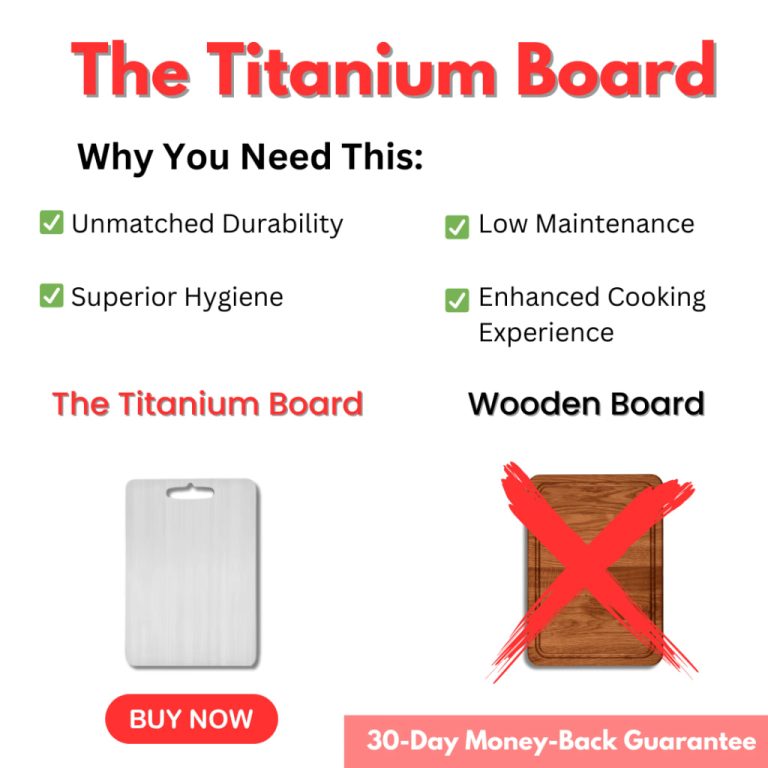When it comes to choosing the perfect cutting board, you might find yourself torn between two popular options: titanium and wooden. Each material has its own unique qualities, and the decision is not as straightforward as it might seem.
Do you prioritize durability or aesthetic appeal? Are hygiene and maintenance your top concerns? As you delve into the world of culinary tools, understanding the differences between these two types of cutting boards could transform your cooking experience. Discover how the right choice can elevate your kitchen routine, enhance your skills, and keep your ingredients fresh and your meals delicious.
Let’s explore the pros and cons of titanium versus wooden cutting boards, so you can make an informed decision that suits your cooking style and needs.
Material Composition
Choosing the right cutting board impacts your kitchen experience. Material composition plays a crucial role. Titanium and wood offer unique characteristics. Understanding these can help make informed decisions.
Titanium Properties
Titanium is known for its strength. It’s lightweight and durable. This metal resists corrosion well. It can withstand high temperatures. It’s non-reactive with food. Titanium surfaces are smooth and easy to clean.
Wood Characteristics
Wood is a natural material. It offers a warm, rustic feel. Different types of wood exist. Each has unique grain patterns. Wooden boards are gentle on knives. They have natural antibacterial properties. They require regular maintenance to stay in good shape.

Credit: www.youtube.com
Durability And Longevity
When choosing a cutting board, durability and longevity are key factors. These attributes ensure the board withstands daily use and lasts for years. Both titanium and wooden boards offer unique benefits in these areas. Understanding the differences can help make a wise choice.
Titanium’s Strength
Titanium cutting boards boast impressive strength. They resist dents and scratches with ease. This makes them ideal for heavy kitchen tasks. Their durability ensures minimal wear over time. Titanium boards stay smooth, even after years of use. They’re also resistant to heat, which adds to their longevity. This makes them a favorite for many chefs.
Wood’s Resilience
Wooden cutting boards offer natural resilience. They tend to heal from cuts naturally. This ability helps maintain their surface integrity. Wooden boards often last for decades with proper care. They require regular oiling to prevent drying. This simple maintenance can significantly extend their life. Wood also provides a gentle surface for knives, preserving their sharpness.
Maintenance Requirements
Maintaining your cutting board is crucial for hygiene and longevity. Titanium and wooden cutting boards differ in their care needs. Let’s explore how to keep each type in top shape.
Cleaning Titanium Boards
Titanium boards are easy to clean. Use warm soapy water to wash them. A soft sponge is ideal to avoid scratches. Rinse thoroughly to remove soap residue. Dry immediately with a clean towel. This prevents water spots and keeps the surface pristine. Titanium’s non-porous nature resists stains and odors. No need for regular oiling or conditioning.
Upkeep Of Wooden Boards
Wooden boards require more attention. After each use, wash with mild soap and water. Avoid soaking them to prevent warping. Rinse well and dry with a towel. Wooden boards need regular oiling. Use food-grade mineral oil. Apply a generous amount and let it soak in. This protects the wood and keeps it from cracking. Sand the surface occasionally to smooth out cuts. Store in a dry, cool place, away from direct sunlight. This helps maintain its natural beauty and durability.
Impact On Knife Sharpness
When choosing a cutting board, one important factor to consider is how it affects knife sharpness. The cutting board you use can significantly influence the longevity of your knife’s edge. You want a surface that complements your cutting technique without dulling your knives prematurely.
Effects Of Titanium
Titanium cutting boards offer a modern solution for your kitchen. They are incredibly durable, resisting cuts and scratches, which is great for maintaining a clean surface. However, their hardness can be a double-edged sword.
Using a titanium board might require more frequent knife sharpening. This metal surface can wear down the fine edge of your blades more quickly than softer materials. You might find yourself questioning if the trade-off between durability and knife maintenance is worth it.
Effects Of Wood
Wooden cutting boards are a classic choice, known for their gentle touch on knife edges. The natural give of wood fibers helps to preserve the sharpness of your knives. This means less time spent sharpening and more time enjoying smooth cuts.
Wood has self-healing properties, which can minimize deep grooves that trap bacteria. Choosing wood over titanium might mean sacrificing some durability for the sake of your knife’s edge. Are you willing to prioritize your knife’s sharpness over the longevity of the board?
As you weigh these options, consider your cooking habits and maintenance preferences. What’s more important to you—knife longevity or a board that lasts through the ages?
Safety Considerations
Choosing the right cutting board involves considering safety features. Titanium and wooden boards have distinct safety aspects. Understanding these can guide your choice in the kitchen.
Bacterial Resistance
Titanium cutting boards resist bacteria well. Their non-porous surface doesn’t absorb moisture. This reduces the chance of bacteria growth. Wooden boards are porous. They can trap bacteria and moisture. Regular cleaning can help maintain them. But they may still harbor germs. Titanium offers a cleaner surface for food preparation.
Risk Of Splintering
Wooden cutting boards can splinter over time. This happens with wear and tear. Splinters can pose a risk to food safety. They may end up in your meals. Regular sanding can help prevent splintering. Titanium boards do not splinter. Their durable surface stays intact. This reduces the risk of contamination. Titanium offers a safer option for food handling.
Aesthetic Appeal
The aesthetic appeal of cutting boards can greatly influence kitchen decor. Choosing between titanium and wooden cutting boards involves more than just functionality. Both materials offer distinct visual styles that can enhance your cooking space.
Modern Look Of Titanium
Titanium cutting boards often shine with a sleek, modern design. Their metallic finish adds a contemporary touch to kitchens. These boards easily fit into modern and minimalist decor styles. The clean lines and smooth surface of titanium create a professional appearance. It’s ideal for those who love a polished look.
Natural Beauty Of Wood
Wooden cutting boards bring warmth and a rustic charm to any kitchen. Each board has unique grains and patterns that tell its own story. The natural hues of wood complement traditional and farmhouse-style kitchens beautifully. Wood’s organic texture can create a cozy and inviting atmosphere. Perfect for those who appreciate nature-inspired aesthetics.
Environmental Impact
Cutting boards are essential in every kitchen. Choosing the right one impacts the environment. Titanium and wooden cutting boards differ significantly in their ecological footprint. Understanding their environmental impact helps make a responsible choice.
Sustainability Of Titanium
Titanium is a durable material. It lasts for many years without degrading. This longevity reduces the need for frequent replacements. Fewer replacements mean less waste. Titanium is also recyclable. Recycling titanium reduces the demand for raw materials. Mining titanium has environmental consequences. It disturbs land and affects ecosystems. Using recycled titanium lessens these impacts. Consider its long lifecycle and recyclability.
Eco-friendliness Of Wood
Wood is a natural material. It comes from renewable sources. Trees are replanted to replace harvested wood. This process supports sustainable forestry practices. Wooden boards are biodegradable. They break down naturally without harming the environment. Wood production is less energy-intensive than titanium. It uses fewer resources and creates less pollution. Choosing wood supports eco-friendly practices.

Credit: www.instagram.com
Cost Comparison
Cost plays a crucial role in selecting the right cutting board. Titanium and wooden boards vary greatly in price. Each option offers unique benefits and challenges. Understanding these differences helps in making a budget-friendly choice.
Price Of Titanium Boards
Titanium cutting boards are known for durability. They resist wear and tear, lasting longer. This longevity comes with a higher price tag. Titanium boards are a premium product in the market. Prices can range from $100 to $300 or more. The high cost reflects their superior material and design. They offer a long-term solution for serious chefs.
Affordability Of Wooden Boards
Wooden cutting boards are often more affordable. They are widely available in many stores. Prices typically range from $20 to $100, depending on the type of wood. Hardwoods like maple cost more than softer woods. Their affordability makes them popular among home cooks. Wooden boards offer great value without breaking the bank.

Credit: cookingpanda.com
Frequently Asked Questions
Is A Titanium Cutting Board Better Than Wood?
A titanium cutting board is more durable and resistant to scratches than wood. Wood boards are gentler on knives and have natural antibacterial properties. Choose based on your needs: titanium for durability, wood for knife care. Both have advantages, so consider what matters most to you in a cutting board.
What Are The Disadvantages Of A Titanium Chopping Board?
Titanium chopping boards are expensive and can dull knives faster. They are heavy and not ideal for portability. Their hard surface can be noisy during use. They may lack the natural antibacterial properties found in wooden boards. Some users find them less aesthetically pleasing than traditional materials.
What Is The Healthiest Type Of Cutting Board To Use?
Bamboo cutting boards are the healthiest choice. They are durable, eco-friendly, and naturally resistant to bacteria. Bamboo’s non-porous surface makes it easier to clean and maintain. Opt for a board with minimal adhesives to ensure safety. Regularly oiling your bamboo board prolongs its lifespan and maintains its health benefits.
Do Titanium Cutting Boards Get Scratched?
Titanium cutting boards resist scratches due to their durable surface. They are ideal for heavy kitchen use. However, over time, minor scratches may appear with sharp or hard objects. Regular care helps maintain their pristine condition. Choose titanium for longevity and reliability in food preparation.
Conclusion
Choosing between titanium and wooden cutting boards depends on your needs. Titanium offers durability and easy cleaning. Ideal for those who cook often. Wooden boards provide a classic look and are gentle on knives. Great for occasional cooks and those who appreciate aesthetics.
Both have their strengths. Consider your kitchen style and habits. Think about maintenance and longevity. Titanium resists wear and tear. Wood requires more care but looks timeless. Decide what suits your lifestyle best. Both options can enhance your cooking experience.
Make the choice that feels right for you.


